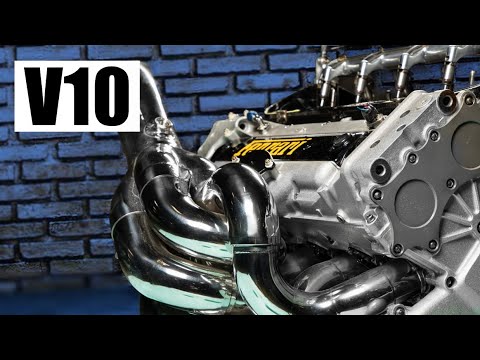Thank you for watching!
Today we’re digging into the V10 era of Formula 1, what some call the golden age of F1. More specifically, why these engines lived such short lives.
During the V10 era and before, it wasn’t uncommon for the engine to be rebuilt after every session during a grand prix weekend. I wanted to learn more about why.
Music by Stomp’s Playlist on YouTube.
Listen to [Applause] This that’s the sound of a naturally aspirated V10 Formula 1 engine a symphony of raw power that captivated and deafened anyone close enough to hear it they push Material Science and Engineering to its absolute limits and set a standard for performance that hasn’t been matched by any production
Engine since even 20 years later Formula 1 engines are marvels of engineering they’ve been on the limit of what’s possible with internal combustion for as long as the sports been around nowadays under the current rules in Formula 1 an engine has to last at least eight races
This is because over the course of a 23 Race season or the 24 races that are scheduled for next year in 2024 teams are only permitted to use three different engines over the course of a season use any more than that and you get a penalty just ask Carlos SS he
Knows all about it sorry for R fans Vegas was amazing though to get the level of performance that modern day Formula 1 cars are capable of and to do it reliably is an incredible engineering challenge and one that would have been impossible for the teams to achieve just
20 years ago without making compromises to be able to produce over 1,000 horsepower from a 1.6 L V6 revving over 10,000 RPM with hours spent at a time at Full Throttle and to be able to do it reliably week in and week out on the same engine pretty much without issue is
A testament to the advances that have been made in design and Manufacturing you know what else is a 1.6 L engine your grandma’s Buick Excel I mean a Honda Gold Wing has more displacement than every Formula 1 car made in the past 9 years but it’s complicated efficient and reliable as the current
Day v6s are in Formula 1 there was a day when sustainability was the last thing on anyone’s mind and it wasn’t that long ago if we go back 20 years to the 2003 Formula 1 season what do we have we have Michael Schumacher domination Groove tires refueling and we also had the v10s
And during 2003 and before this an engine only had to be able to make it the whole race because you had effectively unlimited engines it wasn’t uncommon during this period for teams to run qualifying setups with their engines something that they would do in preparation for qualifying is tear the
Engine down and remove the second piston ring that was only there to help with oil consumption this would allow them to make a little bit more power but it would also burn a lot more oil because you wouldn’t have as good of a seal between the piston and the cylinder wall
And after qualifying they would tear everything back down put that second ring back on the Piston so that they could make it a whole race distance without using up all of their oil and everyone was happy except the mechanics it wouldn’t be until the next year in
2004 when the park F rules started to show up and place limits on what work the team’s could do to the engines during a weekend before that it was basically a free-for-all well this was true for the big teams with big budgets at least engines are expensive the
Average Race distance in Formula 1 in the early 2000s was 190 Mi or 305 km this meant that while Engineers were designing these engines they only had to make sure that they were good enough to last 200 Mi and even though the v10s had gotten pretty reliable by this point
Relative to how they used to be they often still didn’t make it to the Finish Line relative to the engines that we use today many people will argue that the V10 era was the Golden Age of Formula 1 the Turbo v6s from the 80s were borderline uncontrollable the v12s were
Horribly heavy and an efficient and the modern v6s are still looked at as overpowered vacuum cleaners by people who are scared of hybrids and big cities the V8s were great too in the 2000s Ferrari ran a naturally aspirated 3 l V10 engine that often revved past 19,000
RPM making as much as 920 horsepower over 300 revolutions per second and over 300 horsepower per liter from a naturally asp red engine at the beginning of this video I was talking about the V6 engines that Formula 1 cars are now required to run and the insane power that they’re able to produce
They’re much more advanced and in my opinion impressive than the v10s were but it’s important to remember that the modern day v6s are also turbocharged hybrids to make the kind of power that the v10s were making without forced induction and without any electric support like curves for the V8s or the
Hybrid components of the V6 is is a different kind of Challenge and that sound oh that sound now this is great and all but how were these engines able to make so much power in the first place and why did they live such short lives well the power that an engine makes is
Determined by its torque multiplied by its RPM and you can increase power by doing a couple of different things for example you can burn more fuel and add more air by using some form of forced induction like a turbo but the fuel flow is closely regulated in Formula 1 as
Ferrari found out in 2019 and turbos in the ’90s and the early 2000s were banned you can also increase power by increasing displacement no replacement for displacement so I’m told except for boost like in an old muscle car you can create much bigger engines that run at
Much lower RPMs and make a lot more torque however in F1 as we already know you have limits to the amount of displacement that your engine can have so how much torque was the Ferrari V10 making well look at it this way I drive a Volkswagen Golf the f24 with its
Almost 1,000 horsepower made 4 lb feet less torque than my Volkswagen and you can calculate torque by taking the horsepower and multiplying it by 5252 divided by your RPM which for the Ferrari gives us 2 54 lb feet of torque because of these limits on displacements they couldn’t just make a bigger engine
That makes loads of torque and so the engineers decided that the best way to make more power would be to just turn it faster higher RPMs baby more revs more revolutions more power and the reason these engines were able to run at 19,000 RPM for hours at a time is because of
Their small displacement and their very short stroke length in my car the Pistons have to move up and down quite a long way but in Formula 1 that distance is a lot shorter and because that 3 l displacement is divided between 10 different cylinders the bore size can be
Quite small as well so you have super light Pistons that only have to move a little more than an inch meaning they can go really fast most of the v10s on this era had a stroke length that was less than 40 mm which is around an inch
And a half you also have a valve train that’s being powered by pneumatics because at these speeds the Springs wouldn’t be able to move the valve back into its closed position by the time it had to open again you had finally tuned harmonics inside of the engine to make
Sure that they don’t shake themselves apart and the engineers had to reinforce the piston rings because they were fluttering too much at these high speeds these engines were also made with such high tolerances that when they’re not up to operating temperature they’re almost seized in place if you put a regular
Starter motor on an F1 car it probably wouldn’t be able to move the crank at all to get around this Engineers had to come up with a way to artificially heat up the engine before startup and the solution that they came to was to plug what is effectively a preheater to the
Coolant system which pumps hot coolant throughout the engine to heat everything up to the very narrow operating window that the engine is designed to run in my fiance’s Ford Fusion will start up if we’re in the middle of a blizzard and it’ll start up if we’re in the middle of
A desert this is because of special low viscosity oils as well as engineering tolerances that allow everything to move freely inside of the cylinders regardless of thermal expansion but in F1 everything is machined to such tight tolerances that before they get up to Temp the Pistons aren’t even completely
Round they’re actually very slightly oval-shaped and they’re engineered to to become perfectly round once they go through thermal expansion and get up to temperature these are the tolerances that the engineers were working with when they were designing these engines and most of this is still true even with
Today’s engines but in the early 2000s like we already said there was no need for an engine to last more than a couple 100 miles the engine inside of a Toyota Camry can run for hundreds of thousands of miles because it’s built to do so it
Has a wide operating window and has a usable Power Band for everyday use it’s fuel efficient quiet and smooth this is none of those things the only thing teams are worried about when creating an engine like this is making as much power as possible within the rules so when you
Find yourself wondering why old race car engines don’t last very long that’s kind of your answer they’re designed to very tight tolerances and they’re pushed to their absolute limits which means that they come out of Tolerance very quickly let’s look at a lap like Spa which is a
4 Mile circuit one of the longest on the F1 calendar over 72% of this lap is spent at Full Throttle Monza is even worse where you spend 76% of your lap with your foot all the way to the floor this sustained super high RPM puts a tremendous amount of wear on the
Components inside of the engine they ran right to the edge of failure the tiniest fault or misalignment of a part due to wear will immediately Domino throughout the rest of the system which will be disastrous let me give an example of just how much life high RPM takes out of
An engine if we take a look at the Cosworth dp01 champ car the engine that it uses typically has a lifespan of around 400 m or so for a lot of the same reasons that we already discussed to try and cut down on costs the engineers
Wanted to find a way to cut down on the wear and tear inside of the engine so they decided to do an experiment where they dropped the red line from 16,000 down to 12,000 this tripled the life of the engine the V6 hybrids used by
Formula 1 today are able to last as long as they do because of advances in oils lubricants manufacturing and the materials that are used and if the rules during the early 2000s said that the engines needed to last eight races like they do today it would probably be
Possible to make the v10s do it but they wouldn’t be doing it at 19,000 RPM that’s for sure if they ran longer than one race they would have to lower the revs and sacrifice more performance in the name of reliability makes you wonder what the v6s they use today would be
Capable of if they threw out the rule book of course this is nothing compared to the engines that are used in dragsters which need rebuilt after every run but maybe that’s an idea for another video








12 Comments
Keep up the great work!
We want the V8's and V10's engines to return in Formula 1.
They actually get 4 engines per season not 3 because of the extra sprint racing
V10’s 🤤🤤
It wasn't only the quest for power which hampered reliability; making the engine as small and light as possible also had a huge impact. In 1997, Renault's class-leading RS9 V10 weighed around 120kg, revved to 16k RPM and produced about 750HP. Six years later: their RS24 V10 weighed less than 100kg, revved over 3k RPM higher and made almost 200 more horsepower.
they even hat qualifing engines in the v10 era and they lastet a few laps
love your videos man
The V10s weren't the best, during that era there was a serious lack of over taking!
Sorry, but nothing sends me more than the V12's which ended after the 1995 season. The 412 T1 was it!
"engineering that have yet to be matched", I beg to differ. The current crop of engines could literally last a 24hr le mans race, and are also more powerful despite being forced to use less than 1/2 of the fuel the V10 engines once used. The current engines may not sound good, but the fact that a 1050hp racing machine has an energy efficiency higher than a Toyota prius, is insane. If you stuck one of these engines into the back of a F1 car today, you'd have to find a way of putting in 200kg of fuel into the car before the race start to make it to the chequered flag.
I had the pleasure at my club track to witness the set up and drive of a Williams F1 car of a mid 90s vintage. It took 5 engineers to even get the thing ready to roll. The sound was simply glorious and being within 10 ft of it was deafening. When on track and screaming down the front straight, ear muffs were definitely needed even from the 50 yards where I was standing. Obviously the driver and owner was loaded, lol. As I understand it, he had to fly in both Cosworth and Williams engineers. Must be nice to be loaded. lol.
The new engines are amazing, but they lack the passion of the V10s. But maybe that’s just nostalgia